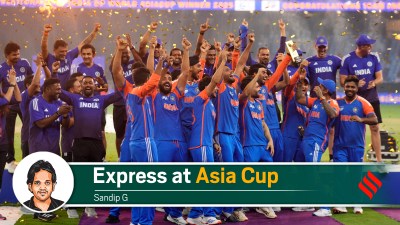The craft of empowerment
It was in 2004 that the College of Home Science at Punjab Agricultural University started a project to provide employment to rural women in their homes
For a small group of women from Aitiana village,some 20 km from the industrial town of Ludhiana,phulkari,a form of traditional embroidery,has become a tool of empowerment. Whether it is Charanjit Kaur,48,Gurmail Kaur,50,or Pawandeep,20,the money from phulkari has helped realise dreams and aspirations. These women have made a profession out of what their mothers and grandmothers practised as a hobby.
It was in 2004 that the College of Home Science at Punjab Agricultural University started a project to provide employment to rural women in their homes. Experts from the college organised the women of this village in groups and got them to work with an NGO,Aagaz. This NGO connects these women with buyers in urban areas.
My husband is a daily wager. His employment is not guaranteed. I joined this group recently and working with these women has helped me earn a steady stream of income, says Satpal Kaur,27.
We have been embroidering phulkaris all my life. It is a craft our mothers and grandmothers passed on to us. But for us,this craft was limited to suits and dupattas. However,now we are embroidering a lot of thingssaree borders,file covers,jackets,even bookmarks. Its much more interesting now, says Gurmail Kaur,50.
Neelam Grewal,dean,College of Home Science,a major force behind this project,explains,The basic idea is to use the potential of rural women and help them earn and empower themselves without having to leave home for work. Phulkari and other forms of embroidery are an integral part of our countryside and most women know the art.
However,with changing times,we felt the need to change the face of phulkari. In earlier times,phulkari was done on garments but now we need the same art on loose material so that buyers can customise the lengths according to their needs. The quality of work also matters a lot and basic facts like the number of stitches per square centimetre have to be kept in mind. It is here that we intervened and trained these women, says Grewal.
What began with baby steps years ago is now growing fast. Women from neighbouring village Sudhar have joined in. Another small group is working in village Sehejra near Barnala.
Sukhwinder Kaur,35,a resident of Sudhar,is a beautician. I run a parlour but still have ample free time. So I joined this group. The extra income that I make from this work means a lot to me but more important is the relationship that we women forge among ourselves. The usual practice is that women sit in a group and work together. At times,two women work on one piece. Urban women bond over kitty parties while we bond over our work, she says.
Young girls such as Pawandeep and Karamjit too have joined this group. I quit studies after class XII but didnt want to sit idle at home. My parents will not allow me to step out of the house and work. Getting an opportunity to work from home is like a blessing, says Pawandeep.
Preeti Kansal of Aagaz says,Our NGO gets orders from buyers which we pass on to these women. Everythingthe fabric,colour schemes,designsis according to the requirement of the buyer. We are even looking at the export potential of the phulkari,especially in middle-east countries. However,a lot still needs to be done because phulkari is now also being done by machines which is way cheaper than hand embroidery. However,buyers need to realise that not only is hand embroidery providing employment to so many women, its also preserving a traditional skill.
A delicate craft
This traditional embroidery of Punjab holds special significance. A baagh (long dupatta) made of phulkari is an integral part of a wedding ceremony in the state. Originally done on khadi or halwan,phulkari has now been modernised to suit present times and is done on all kinds of fabric. The most popular baagh is called Bawan Baagh (bawan for 52),a collection of 52 patterns and designs used in phulkari. In Sheesh Baagh,all the embroidery is done in white,which looks like mirrors on the dupatta. Moranwala Baagh has peacocks embroidered on it. Traditionally,the base colours are red and its shades,though this too is no longer fixed. The tradition of phulkari is also found in some parts of Pakistan while in Iran it is called gulkari.





- 01
- 02
- 03
- 04
- 05


























